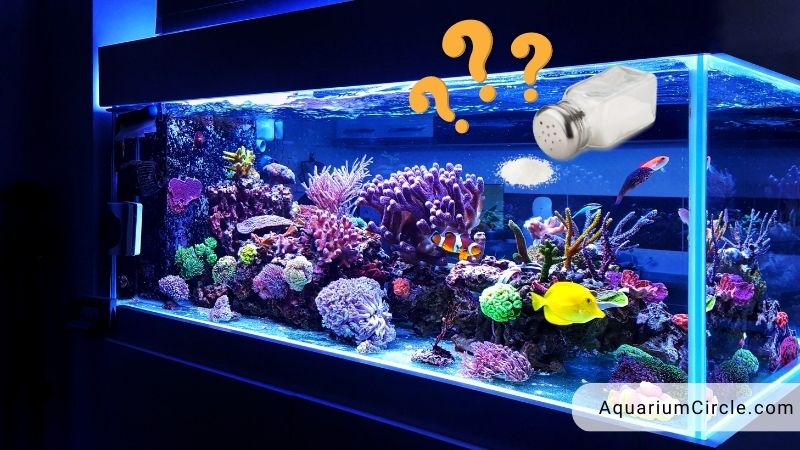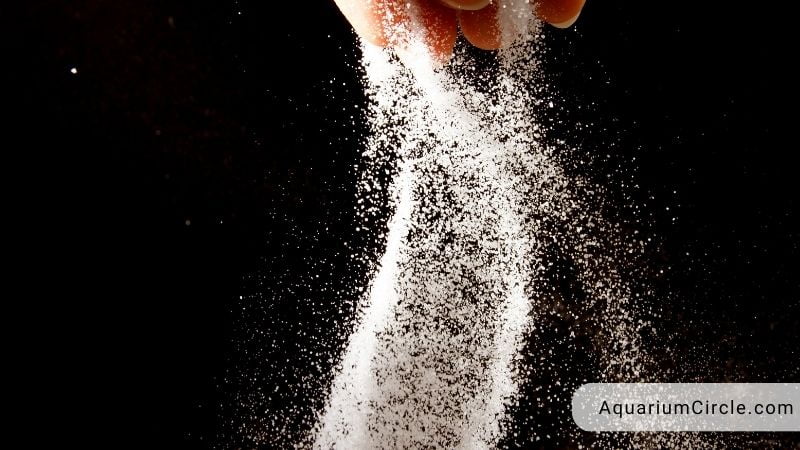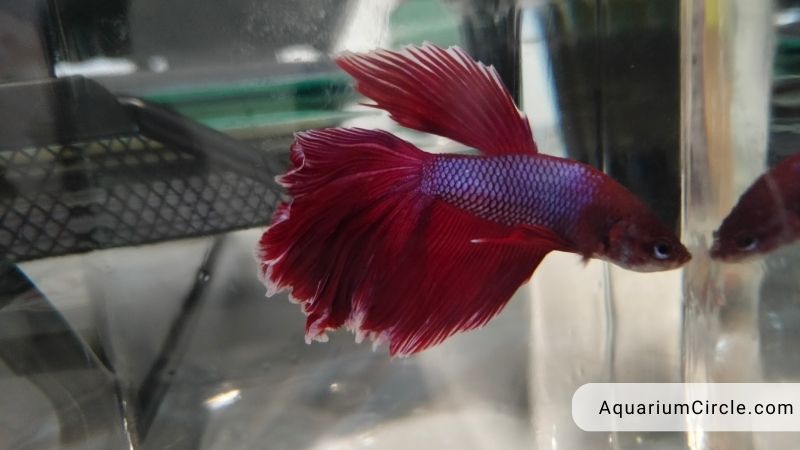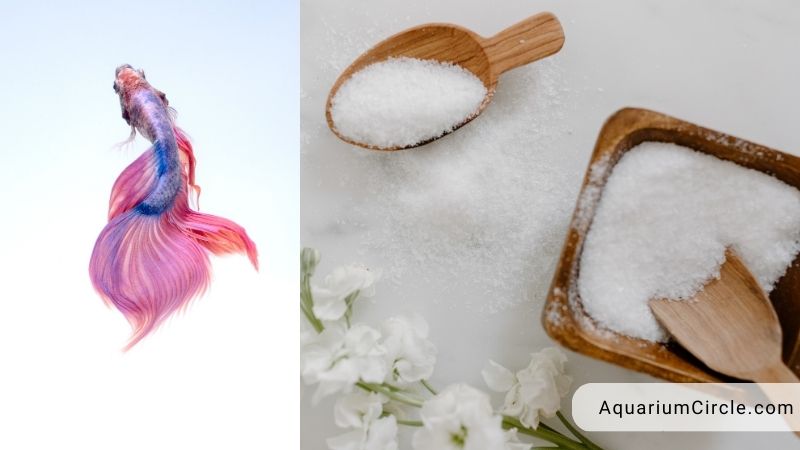Many betta owners use aquarium salt to cure common diseases in their betta fish and even to improve the betta’s general health. But freshwater species like the betta fish don’t dwell in salt water. What makes aquarium salt so acceptable, and is it safe for your betta friend?
In this post, we’ll look more closely at the possible applications of aquarium salt for betta fish and discuss how, when used correctly, salt may be good for your fish.
What Is Aquarium Salt For Betta?
Chemically speaking, table salt and aquarium salt are very similar. Both of these salts have the chemical formula NaCI, which stands for sodium and chloride in a 1:1 ratio. The main and most significant distinction between aquarium salt and ordinary salt is that the latter doesn’t include any additives. Seawater that has evaporated is a simple source of aquarium salt.
Sodium chloride used in aquarium salt is untreated. We use aquarium salt frequently in freshwater aquariums to treat a wide range of illnesses and increase fish health. Because they don’t include iodine or anti-caking agents, rock salt and Kosher salt can be used in place of aquarium salt.
What Are The Benefits Of Aquarium Salt For Betta?
When you don’t have a disease-specific treatment at home, it’s better to think of aquarium salt as a type of first aid. So, turn to proprietary, over-the-counter disease-specific medications if symptoms still exist after use.
The electrolytes in aquarium water must be replenished for your Betta to be able to take in oxygen and expel CO2 through its gills. Therefore, aquarium salt may aid. Your Betta tank’s water’s nitrite and nitrate levels will drop if you add aquarium salt. The capacity of aquarium salt to eradicate specific bacteria, fungi, and parasites in a betta fish tank is one of its greatest advantages. Since it effectively causes death by dehydration, it is efficient at treating a variety of parasitical, fungal, and bacterial ailments.
Moreover, it might stop methemoglobinemia. Your Betta’s gills and kidneys will work better with aquarium salt. This is a big benefit because the kidneys of the Betta play a crucial part in eliminating water from its body.
Betta fish illnesses such as velvet, ich, dropsy, and fin rot are alleviated with aquarium salt. Your betta fish’s sores and open wounds, like fin rot or an injury received from another fish, might heal more quickly if you give them a salt bath or add aquarium salt to their tank.
Although aquarium salt lessens the amount of work your betta’s body needs to do to function, such as the kidneys and gills, it can help lower stress levels in freshwater fish tanks. This is very helpful for sick fish who need a little additional assistance to recover.
How To Use Aquarium Salt For Betta?

As was already said, the only salt that can effectively treat Betta fin rot and other ailments is aquarium salt. We advise you to begin with the lowest dose. Make careful you only add aquarium salt to the Betta fish tank when you change the water.
Aquarium salt won’t evaporate or be removed by the Betta tank’s filtration system. Adding more salt to a tank that already contains a dosage will definitely kill your Betta because extended exposure to salt is bad for fish and can burn their skin.
How much aquarium salt should we use?
- Mildest dose: For every three gallons of water, add one tablespoon of salt. Either directly add the specified amount of salt to the water or first dissolve it in a tiny amount of tank water. Even though this is the lowest dose, Betta fin rot and other bacterial and fungal diseases of Betta fish can still be properly treated with it.
- Medium dose: A spoonful of aquarium salt should be used for every two gallons of water for a more effective dosage. This dose can be used to treat ich, skin flukes, and fungus, in addition to moderate fin rot in Betta fish.
- Highest dose: One tablespoon of aquarium salt for every gallon of water is the maximum amount of salt you may add to your Betta tank without endangering the freshwater fish. You run the risk of eradicating all aquatic life in freshwater aquariums that are homes to scaleless species and plants if you use them.
Replace 30% of the water initially, then watch your Betta for a week. Don’t then salt the aquarium water after it has been changed. Repeat the process of changing 30% of the aquarium’s water without adding salt if your Betta’s condition stays stable. Restart the treatment if your Betta’s condition deteriorates.
Avoid overdosing
You must treat your betta tank with the appropriate amount of aquarium salt. You run the danger of damaging your betta’s skin if you oversalt the tank. Remember to perform the above-mentioned partial water changes throughout treatment. Don’t just keep salting the water more and more!
How Does Aquarium Salt Work?
Also, as the amount of salt in the water rises, these dangerous organisms osmotically lose water. Osmosis is the process by which a liquid moves through a permeable membrane from an area with a low salt concentration to one with a high salt content. The parasite’s skin serves as the membrane in this instance. Hence, all the fluid within the parasite is pulled out when the surrounding water has a higher salt content than the parasite’s body. Due to their little size, these creatures are more prone to dehydration than their fishy hosts and will perish in aquariums with salt concentrations suitable for Betta fish.
However, some pathogens aren’t as vulnerable to salt, so it’s a good idea to back up aquarium salt with a chemical treatment.
In these cases, the goal is to let the aquarium salt work to hasten the healing process. Because betta fish live in freshwater and shouldn’t be exposed to salt water for an extended amount of time, this kind of salt should not be used haphazardly. The addition of this salt would be damaging if the fish weren’t sick, despite the claims of some betta keepers that it would enhance the fish’s color.
Can We Use Something Else Instead Of?

No! Aquarium salt should never be used in place of conventional regular salt. The pH level and water quality in the tank can both be impacted by the use of table salt. Moreover, aquarium salt will replenish the water’s natural electrolytes, while table salt won’t. Both of those salts have ingredients that might hurt or even kill your betta friend, including coloring, flavor enhancers, and other things. You can isolate the ill Betta and give it a salt bath or salt dip rather than salting all the aquarium fish and plants.
- Salt bath: A salt bath is an excellent option for adding aquarium salt to the tank because it allows you to treat any bacterial infections your Betta may have more quickly. They work well in the treatment of other illnesses, such as swim bladder disease (Epsom salt bath).
- Salt dip: You submerge the fish for a few minutes in moderately concentrated aquarium saltwater rather than adding salt to a space shared by other marine life.
Can Aquarium Salt For Betta Treat Diseases?
Popeye and fungal diseases or some fish diseases can be successfully treated with aquarium salt. If you don’t have any disease-specific medications on hand, aquarium salt treatment works best as a first-aid remedy. You should always turn to employing a proprietary disease-specific medication if using salt doesn’t make the problem better.
Fin rot
If your betta has mild to moderate fin rot, you can help them get well by adding salt to the water in its aquarium. If your main tank contains scaleless fish, live plants, or other aquatic life, you should move your betta to a hospital tank before using aquarium salt to treat the fin rot. Use 1 tablespoon of salt per gallon of water to treat minor fin rot.
2 to 2.5 tablespoons of salt per gallon of water may be necessary for more severe cases. Replace all of the water in the quarantine tank with fresh, dechlorinated water after 24 hours, and then replenish it with the same amount of salt as before. For up to 10 days, keep doing this.
Dropsy
Dropsy is not an illness but rather a symptom because it frequently occurs in conjunction with other conditions, such as liver failure, bacterial infections, or fungal infections. Aquarium salt can help pull out some of the water and fluid in your betta’s body to boost its chance of survival. Still, the condition is notoriously difficult to treat unless you address the underlying issue.
Columnaris
Columnaris, often called cotton wool sickness, is a bacterial infection that can affect your fish internally or externally and result in cottony, white growths on its body. Together with a bad diet, stress, and a warm water temperature, it is frequently brought on by poor water quality in freshwater tanks. Aquarium salt can be used to treat cotton wool disease because it lowers osmotic stress and aids in the battle against infection.
Slight fungal illnesses
Your finned buddies may develop fungal illnesses as a result of contaminated water. When the water temperature is lower than what they require, bettas may contract fungal diseases.
If you put aquarium salt in the quarantine tank, you can quickly cure your Betta of the infection. However, if the infection doesn’t go away after a few days, you’ll need a vet’s professional advice and medication.
Is Aquarium Salt Safe For Betta?

Because aquarists may get away with using modest amounts of aquarium salt to cure fish infections, aquarium salt is safe to be used for betta fish in aquariums. Aquarium salt should only be introduced to an aquarium when necessary to cure specific fish ailments. It is safe to use a small quantity of salt in a betta tank to treat some illnesses, so long as you don’t overuse the water.
Increase bacterial
You run the danger of destroying the water’s helpful nitrifying bacteria, which naturally break down organic waste and filter the Betta tank. The less clean the tank is as a result of losing them, making your ecologically sensitive betta more prone to illness and stress-related fin rot. Hence, before treating your betta with aquarium salt, we strongly advise keeping it in a quarantine tank. When quarantining the fish isn’t an option, the final step should be to add aquarium salt to the tank.
With live plants
If your betta is housed in a tank with live plants or scaleless fish, it might not be a good idea to add aquarium salt. Live plants with a low tolerance for salinity could be harmed if aquarium salt is added straight to the aquarium water.
With scaleless species
Scaleless fish, such as the Pictus Catfish, lose their natural defense against parasites and illnesses as a result of the drying effects of salt. This also applies to snails, who won’t fare any better. Indeed, they’ll probably perish as a result of osmosis drying off their natural mucus.
FAQs
Does aquarium salt adjust the pH level of the betta tank?
A betta tank’s water pH is not considerably impacted by aquarium salt. Although it might have a small effect on pH, it usually isn’t enough to make a big difference. In order to provide your betta fish with a stable environment and healthy living conditions, it is crucial to constantly check the pH level of the water and make modifications as necessary.
Should we use aquarium salt for new fish?
Aquarium salt shouldn’t typically be applied to new fish right away after arrival. Prior to administering any therapies, it’s critical to keep an eye out for any signs of stress or illness in the fish. There might not be a need to use aquarium salt if there are no symptoms of illness or stress. Imagine, though, that the fish is displaying signs of sickness or is under stress from the transport. Then, after contacting a veterinarian or fish specialist, aquarium salt may be utilized as a remedy.
How can aquarium salt affect the snails?
Because of their sensitivity to salt, snails might suffer from aquarium salt. Increased salt exposure can cause mortality, dehydration, damage to cells and tissues, and more. Snails and other invertebrates may also be harmed by a buildup of salt that develops in the substrate and filter media.
References:
- Betta Fish Guide – https://www.bettacarefishguide.com/aquarium-salt-for-bettas-faq/
- Salt – https://www.theaquariumwiki.com/wiki/Salt

Annette M. Chaney is an experienced marine biologist with over 20 years of experience as an aquarist and fishkeeper. She started her first aquarium at a young age, filling it with frogs and goldfish obtained from the ten-cent pet store.
Annette grew up caring for and breeding African Cichlids, which led to a hobby in high school that doubled as a profitable means. Attending Reed College gave her time to solidify herself as an accomplished aquarium caretaker with an eye for sales. After that, from 2009 – 2013, she studied at Roger Williams University – one of the most prestigious universities for Aquaculture and Aquarium in USA. She is the founder of AquariumCircle since 2010.
